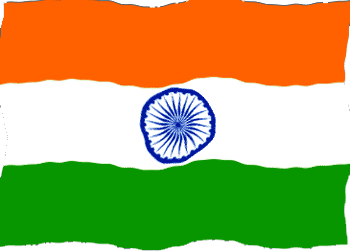Zamindar
A zamindar or zemindar (Hindi: ज़मींदार zamīndār, Urdu: زمیندار zamīndār, Eastern Nagari: জমিদার jomidar), was an official employed by the Mughals to collect taxes from Ryots (peasants).The zamindari system used the existing structure of the bhuiyan land tenure system of the pre-Mughal era by the Mughals as a key economic and political institution to implement the sharia-based Islamic rule over the "zimmis".The practice was continued under British rule with colonial landholders. After independence, however, the system was abolished in India and East Pakistan (present-day Bangladesh); it is still current in modern Pakistan.
Other terms were and are used in various provinces. For example, a zamindar is known as a wadera in Sindh. In Rajasthan , Uttar Pradesh, Madhya pradesh, Himachal pradesh, Haryana, Uttrakhand, Chhatisgarh, Bihar it is Thakur. In the Punjab and Haryana, many different terms occur, such as chaudhary, lambardar, and sardar. Malik is an Arabic term used in the Punjab which literally means "king". The word zamindar itself comes ultimately from Persian zamīn, "earth", and the common suffix -dār, "-holder" (as in many of the terms above).
Mughal era
In the Mughal Era, the zamindari system began to ensure proper collection of taxes during a period when the power and influence of the Mughal emperors was in decline. With the Mughal conquest of Bengal, "zamindar" became a generic title embracing people with different kinds of landholdings, rights and responsibilities ranging from the autonomous or semi-independent chieftains to the peasant-proprietors. All categories of zamindars under the Mughals were required to perform certain police, judicial and military duties. Zamindars under the Mughals were, in fact, more the public functionaries than revenue collecting agents. Although zamindaris were allowed to be held hereditarily, the holders were not considered to be the proprietors of their estates.
The territorial zamindars had judicial powers. Naturally, judge-magistracy, as an element of state authority conferred status with attendant power, which really made them the lords of their domains. They held regular courts, called zamindari adalat. The courts fetched them not only power and status but some income as well by way of fines, presents and perquisites. The petty zamindars also had some share in the dispensation of civil and criminal justice. The Chowdhurys, who were zamindars in most cases, had authority to deal with the complaints of debts, thefts and petty quarrels and to impose paltry fines.
British era
Zamindar was the name of landlords in colonial India.
The zamindari system was a way of collecting taxes from peasants. The zamindar was considered a lord, and would collect all taxes on his lands and then hand over the collected taxes to the British authorities (keeping a portion for himself). The similarities tomedieval feudalism are evident.
In the 18th century, when English and Scots merchants and adventurers began to settle in Mughal India in significant numbers, they noticed a superficial resemblance between the role and status of the zamindari and the landed gentry the squires or lairds that were once typical of the British Isles.
Like the zamindari, the English squires and Scots lairds were the leading proprietors in their villages. In addition, they were often entrusted with important judicial and governmental functions, by the Crown in their capacities as Justices of the Peace. It was natural for the British incomers to assume that the zamindari of northern India were a kind of local squirearchy, although there were important differences. Some new Zamindars were old Rajas. Many descended from eighteenth century revenue speculators and military adventurers. Several families are of very ancient lineage, like those claiming Bargujar ancestry and had always been independent rulers at earlier periods of Indian history. They frequently intermarried with the ruling families of the princely states. Their tenants numbered from dozens to many thousands, and under imperial law, had to pay rent to Zamindars to retain rights to their land.
Under the British some of the formerly independent Indian states that were given the status of zamindaris. Some of these zamindars held title to vast tracts of land, which they were required to pay annual rents to the Government of British India. The zamindar of Burdwan was the single largest tax payer in the British Empire, and was referred to as “Maharaja” but in his case it was a non-ruling title and not a princely one. Burdwan and other zamindaris like Raj Darbhanga (The largest zamindari of India with higest monthly income), Bettiah Raj and Dumraon were very wealthy and lived like royalty.The second line of big zamindaris included Balrampur,Sahaspur-bilari,Jhangirabad,dhampur. Other zamindars, i.e. Cossimbazar and Tekari Raj, apart from there used to be small estates such as kanhauli in the Muzaffarpore dristrict along with two more estates. Prior information are available for the kanhauli Estate which was run by local zamindars.The estate was having a Monthly income of approx Rs three lakh and area covering Thirtyfour thousand acres of land in different districts with a vast managerial bungalow in kanhauli village and hazipore town. Banglows namely Deorhi mansion,lalpakka were generally large and spacious, built of red stone and rose/teak/sandal wood, with a wraparound porch and rooms leading off from a large central courtyard. The mansion was a part of a vast estate.It also had a magnificent and monumental gate, Singh Dwar.The budget of daily expenditure was a part of their revenues.Inorder to improve the lot of their tenants,they opened schools, temples and other public institutions. By the zamindari system all the public lands were brought under the zamindar's control.



1 comments:
Mr. Haider! I'm also a vivid reader in zamindari n clan history. Despite my much research, I could not find an exhaustive list of Zamindari aboliished by Zamindari Abolition Act of UP. Can you help me by referring any document/ publication containing notifications in this regard. My email is aggdeep@yahoo.com - Deepak Aggarwal
Post a Comment